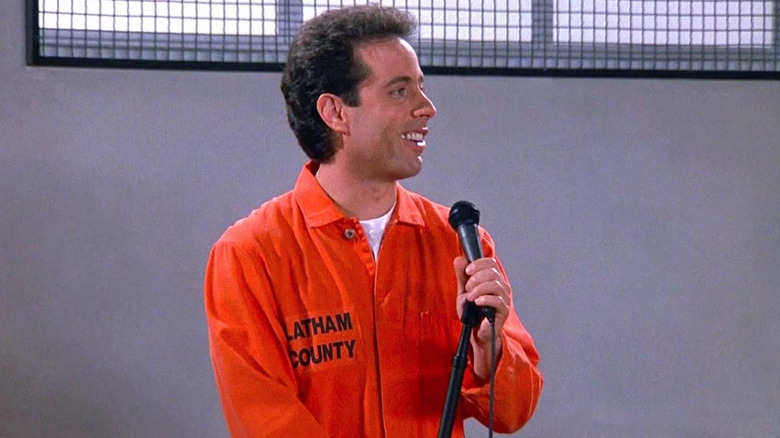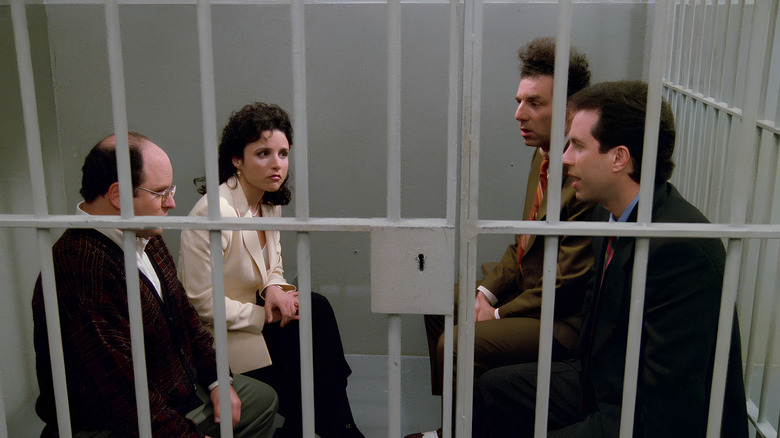The Last-Minute Addition To The Seinfeld Finale That Changed The Show
It's important to remember that the four lead characters of the popular sitcom "Seinfeld" — Jerry (Jerry Seinfeld), Elaine (Julia Louis-Dreyfus), George (Jason Alexander), and Kramer (Michael Richards) — are not good people. Most of the plots of "Seinfeld" episodes stem from their petty grievances, neurotic complaints, and unsophisticated discomforts. The central quartet were insensitive, callow, rude, self-indulgent, and weak-willed. They weren't ever presented as aspirational or even admirable. This spring from a mandate laid out by the series' co-creators Seinfeld and Larry David, namely: the show was to feature no hugs and no lessons. It was to be about nothing. This was to be a sitcom completely devoid of morals and sentimentality.
As such, it made perfect sense for the star characters to end the show in prison. In the two-part finale, called "The Finale" (May 14, 1998), the four of them witness a man getting carjacked at gunpoint and choose to mock the victim's weight rather than help. Jerry, Elaine, George, and Kramer are arrested under a Good Samaritan law that would have required them to help a citizen in need.
At their trial, the four would have to face multiple character witnesses V people they met throughout "Seinfeld's" nine seasons — who laid out the depths of their selfishness and indifference. They would all be found guilty and sentenced. The final scene of the series was of Jerry performing a stand-up routine behind bars. They learned no lessons and distributed no hugs.
It seems that the original plan for "The Finale" was to see George, Elaine, Jerry, and Kramer locked in a jail cell having a conversation about buttons. A meaningless conversation to end a show about nothing. It wasn't until Seinfeld himself had a better idea that the final scene was moved into the prison itself. Seinfeld talked about his idea for the "Seinfeld" season 9 DVD box set.
Seinfeld comes full circle
The meaningless conversation about buttons, by the way, is the exact same conversation that started the show in its premiere, nine seasons earlier. Jerry notes that the number of buttons one has fastened on their shirt can make or break it. George comments that they had the conversation before. There's no laugh track. Their lives are meaningless, but there was a sentimental element to it; the conversations will continue. They still have each other, and their whimsy will continue forever.
Seinfeld felt that wasn't a good enough ending for the show, though. The "Seinfeld" episodes were predicated on a loose premise that the main characters' daily adventures served as the inspiration for Jerry's stand-up routines. Stand-up was really the bedrock of the series. As such, Seinfeld felt that the series should end with him on stage, as he was typically seen throughout the show. Writers Max Pross and Tom Gammill felt the secondary ending was more appropriate for the series. These were, after all, selfish, horrible people. Jason Alexander agreed, feeling that George in particular should end up in prison.
It may be ironic that "The Finale" wasn't widely beloved by "Seinfeld" fans. Indeed, /Film even noted that it was the worst episode of the show. The jokes weren't as frequent, and the bulk of the episode dwelled aggressively on the protagonists' shortcomings to an almost cruel degree. It could be argued that it wasn't necessary to punish Jerry, George, Elaine, and Kramer at the end of "Seinfeld," as they frequently ran into cosmic punishments and discomfort as a direct result of their actions. Eventually, even Seinfeld expressed regrets, saying that the characters should have been freed.
But then, in a meaningless series about horrible people who never learn lessons, throwing them in prison — and seeing that the experience has left them unchanged — was kind of perfect.

